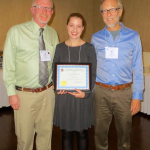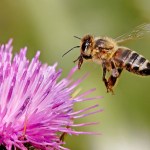
I am very excited to report this year's awardees from the Comparative and Evolutionary Physiology Section (CEPS) of the American Physiological Society!
The New Investigator Award is given to a young investigator who has made contributed significantly to the field of comparative and evolutionary physiology. This year's awardee is Casey Mueller from California State University, San Marcos.
Casey Mueller (middle) receiving the New Investigator Award. She is standing with the CEPS Chair, Dr. Michael Hedrick (left) and the 2016 August Krogh Distinguished Lecturer, Dr.…
Today was the final day of the meeting.
Dr. Joe Thompson (Franklin and Marshall College) spoke about oblique striated muscles, which get their name from the diagonal pattern formed by the location of the Z-lines. This type of muscle is common among cephalopods, nematodes, tunicates, molluscs, etc.
Dr. John Whiteman (University of Wyoming) gave a fascinating talk about polar bears and whether hunting on the shore as compared to the sea ice helped the animals replenish stores after hibernation or fasting as well as how foraging patterns affected activity levels.
Dr. Michael Butcher (…
This year's August Krogh Distinguished lecture, the highest award given to an accomplished Comparative Physiologist from the Comparative and Evolutionary Physiology section of the American Physiological Society was awarded to Dr. Jon Harrison, Arizona State University.
Dr. Harrison gave an outstanding seminar in which he reviewed some of his major research discoveries. His work has included examining how insects tolerate various temperatures and how changes in the levels of atmospheric oxygen may relate to variations in insect growth and overall body size. He has also examined the mechanics…
Still going strong...here are the highlights from several sessions held on Day 4:
Drawing of Lake Whitefish by William Converse Kendall - Kendall, William Converse, b. (1909) Fishes of the Connecticut Lakes and Neighboring Waters, with Notes on the Plankton Environment, Report of the Commissioner of Fisheries, 1906-1907, Washington, DC: Government Printing Office, p. 39 Fig.1, Public Domain
John Eme (California State University, San Marcos) presented data testing the effects of varying temperatures mimicking overwintering conditions on embryonic development of Lake whitefish. He…
I LOVE THIS MEETING!
DAY 3 included several very interesting comparative physiology sessions.
Image of birds from Wikipedia
Eldon Braun (University of Arizona) spoke about how birds have a unique way to prevent water loss and thereby dehydration. In mammals, the kidneys are responsible for recovering water from the urine. However when birds are well-hydrated, the urine enters the colon and moves backwards up the gastrointestinal tract to facilitate water reabsorption prior to voiding the urine.
Hiroko Nishimura (The University of Tennessee) spoke about work she had done over the years…
Today was a great day for trainees in comparative physiology! Here are some of the highlights from their sessions:
Poster presentations:
Alexis MacDonald et al., (Union College - Mentor Dr. Scott Kirkton) presented research showing that grasshopper skeletal muscles may use lactate for energy!
Similarly, Dongying Wang et al., (Saint Louis University - Mentor Dr. Daniel Warren) also showed that skeletal muscle from painted turtles may use lactate.
I guess it is not just a waste product of exercise after all...
Oral Presentations:
Image of pupfish by Nevada Fish &…
Today marked the official start of the Experimental Biology meeting for the American Physiological Society!
The highest award the society offers a scientist is named in honor of Dr. Walter B Cannon, the physiologist (and 6th President of the society) who came up with the term 'homeostasis' in his 1930 book The Wisdom of the Body. This year's award recipient is Dr. Amira Klip from the University of Toronto. In her presentation she described her research on how poor nutrition can activate the immune system to cause insulin resistance in muscle. Fascinating! This was a grand…
I am packing my bags and heading out to sunny San Diego for the annual Experimental Biology conference, which officially kicks off today!
Photo by: Myrabella / Wikimedia Commons, via Wikimedia Commons
With the approach of summer, a timely study was published in the American Journal of Physiology - Regulatory, Integrative and Comparative Physiology on whether inflammation plays a role in heat stress-related complications in muscles. Heat stress is a major problem in the livestock industry. In the United States alone it is reportedly associated with a loss of approximately $158 billion annually in the swine industry. To cool off, swine seek shade and often mud baths (which mimic sweating by …
Don't forget to vote for your favorite Phantastic Physiology Voyage video from trainees sponsored by the American Physiological Society. This year's theme is “Function Follows Form.”
Here is just a sample of the phantastic videos (from YouTube) in the contest:
To see the rest of the videos and vote for your favorite, click here!
I am getting my poster presentations ready for the Experimental Biology conference next week in San Diego. In my opinion, this is one of the most exciting conferences as we get to hear about the latest physiology research. I cannot wait to share what I learn with you!
Here is a YouTube video with just some of the reasons others love attending these conferences as much as I do. This video was filmed at the meeting in Boston last year.
I came across this neat video summarizing a study that found some birds build nests near alligators to protect themselves from other predators. But the protection is not without a price.
Image of honeybee By Fir0002 (Own work) [GFDL 1.2 (http://www.gnu.org/licenses/old-licenses/fdl-1.2.html)], via Wikimedia Commons
A new study conducted by researchers at the University of Guelph found that the use of certain pesticides impacts wildflower pollination by bees. According to a quote by study author Nigel Raine, published in CBCNews, the use of neonicotinoid-type pesticides "modify the way in which information flows through the nervous system."
The research team found that bees gather pollen more frequently, but less efficiently, when exposed to the pesticide compared to…
Image of ruby-throated hummingbird by Joe Schneid, Louisville, Kentucky (Own work) [CC BY 3.0 (http://creativecommons.org/licenses/by/3.0)], via Wikimedia Commons
In a new study published in The Auk, scientists report that well-fueled older tiny Ruby-throated Hummingbirds (Archilochus colubris) might be capable of non-stop flights of over 4,000 kilometers, wind conditions permitting. They made this remarkable observation while studying birds from 2010-2014 as the animals made stopovers at a wildlife refuge during their annual migration to South…
A special thank you to reader Dr. Barbara Goodman, Professor of Physiology at Sanford School of Medicine of the University of South Dakota who sent me a story from The Scientist about sleep in animals complete with footage of a dolphin that was seen apparently "sleeping" (video posted on YouTube):
Why do animals sleep? This is a question with many potential answers. It is known that birds and mammals experience slow-wave and rapid eye movement (REM) sleep patterns. During the first pattern, slow waves with high amplitudes can be seen if measuring electrical…
Tennessee Walking Horse photo by Just chaos. https://commons.wikimedia.org/w/index.php?curid=7128467
In a new study published in Physiological Genomics, researchers explored the role of genetics in the conformation of Tennessee Walking Horses. In other words, how close each animal they sampled looked to an "ideal" Tennessee Walking Horse. According to Kylee Jo Duberstein (Department of Animal and Dairy Science, University of Georgia), there are five criteria that are examined when evaluating the conformation of a horse. These include "balance, structural correctness,…
NOAA image of a possible new species of octopus discovered near Hawaii. Photo credit: AP, NOAA
Scientists from the National Oceanic and Atmospheric Administration (NOAA) think they have discovered a new species of octopus while exploring the ocean floor around Necker Island (near Hawaii). The octopus was found 4,290 meters deep. Interestingly, fins were absent from the pale octopus, which NOAA scientist Michael Vecchione noted was unusual for an octopus living at that depth. Moreover, its suckers were found to be in a single row on each of its arms, as opposed to two rows.…
Despite their reputation as nuisance species, modern pigeons are pretty smart:
Here are three other cool facts about pigeons:
Videos from YouTube.
Image of dodo bird skeleton and model By BazzaDaRambler - Oxford University Museum of Natural History ... dodo - dead apparently.Uploaded by FunkMonk, CC BY 2.0, https://commons.wikimedia.org/w/index.php?curid=20054563
Using computed tomography (CT) scans of an intact skull, researchers have discovered that extinct dodo birds (Raphus cucullatus), despite having a rather silly name, were actually pretty smart. Well, as smart as a pigeon at least, and pigeons are pretty smart. Dodos likely also had a good sense of smell based on measurements of the olfactory portion of…
Image of gilthead sea bream By Roberto Pillon - http://www.fishbase.us/photos/UploadedBy.php?autoctr=13070&win=uploaded, CC BY 3.0, https://commons.wikimedia.org/w/index.php?curid=20825139
A new study published in the American Journal of Physiology - Regulatory, Integrative and Comparative Physiology explored the effects of exercise on growth and hormone regulation in gilthead sea bream (Sparus aurata). The main hormones that regulate growth are, perhaps not surprisingly, growth hormone and insulin-like growth factor. Researchers discovered young gilthead seam bream that underwent…

